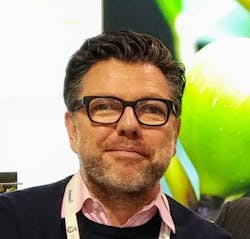OSIsoft announced in late July that Michael Siemer will joining OSIsoft as president while Wolfgang Kuchen came to the data technology company as senior vice president of sales and marketing.
Siemer, an energy industry veteran with experience in leveraging software technologies to transform complex industrial operations, comes to OSIsoft from Devon Energy Corporation, a North American oil exploration and production company, where he served as vice president of engineering, exploration and production, data and analytics.
Michael Siemer, OSIsoft, company president
Kuchen, meanwhile, brings more than 20 years of experience providing financial, strategic and operational leadership in business environments. Most recently, he served as president of Allergy Research Group (ARG), a Kikkoman portfolio company in the healthcare professional market.
Both Siemer and Kuchen will also serve on OSIsoft's newly formed executive committee. Siemer will officially begin in September, while Kuchen began in August.
Siemer and Kuchen answered 7 questions about the organization and how technology is affecting the industry.
What are three key things that a machine builder, system integrator or manufacturer should know about your company?
Siemer: First and foremost, we want them to know we’re focused on one task: developing software that helps people understand and use the data from their critical operations to improve their business. Operational data is an incredibly valuable asset. It can be used to get more productivity and life out of capital equipment that might be two or three decades old or meet a new and ambitious set of sustainability goals. Unfortunately, it can also be extremely difficult to use, particularly in real time. Some organizations track over 7 million data streams and often data streams have to be combined in a digital model to make sense. It can be overwhelming. I think part of the reason the PI System has become pervasive is the focus on making data management and access more seamless.
The second thing they should understand is that the PI System may be different than what they think it is. If you ask people to describe the PI System, they’ll often call it a historian or time series database, i.e. a system for storing, but not necessarily actively accessing, data. In fact, the PI System started as a historian and performs quite well as one. Over the years, though, OSIsoft has added capabilities like Asset Framework and PI Vision, and the PI System has evolved into a decision support platform. Employees at a large gold mine, for instance, use the PI System to dynamically change their flotation streams to increase metals extraction. Many utilities rely on it for condition-based maintenance for transformers and other remote, expensive assets.
The third thing to note is that we’re continually expanding our ecosystem and product portfolio. A growing number of companies are embedding PI System technology into their smart appliances. We’re also always adding more system integrators. If we work together, we can grow the market.
What new technologies are driving your product development and why?
Siemer: Cloud and edge technologies will drive a substantial portion of our development and will play an even bigger role in our future portfolio. The attitude industrial companies have about the cloud has completely flipped in the past five years. Don’t expect to see companies suddenly shift everything to the cloud, but you’ll see them start to use it for amalgamating data or connecting remote assets. Edge technologies, meanwhile, are opening a market for smart devices.
We will also continue to expand our capabilities in visualization. The ultimate goal is to create an environment where people can leverage data to make better decisions. Visualization can help eliminate confusion and make it easier to focus on the truly critical issues.
Another influence will be the development of best practices and technologies for integrating analytics or other new services. Industrial customers are cautious for good reason-- they have millions of hours and billions of dollars invested in their facilities. Any change can have significant and unanticipated changes. More knowledge about adoption and integration will accelerate the market.
Wolfgang Kuchen, OSIsoft, senior vice president of sales and marketing
How does the Industrial Internet of Things figure in your business strategy?Kuchen: It depends whom you ask! To an operations engineer, IoT means adding sensors and software to devices they’ve never had the opportunity to connect. Some call this the secondary network and there is a whole armada of devices out there waiting to be linked. To an IT person, however, “IoT” means taking OT data and integrating it into their business apps to save money or improve safety. OT might tell you that’s old hat—we’ve been doing this for years!--but it’s new to IT. Suffice it to say we’ll develop products for both definitions. OT will see more edge technologies while IT will see more connectors and cloud tools for bringing operations data from the field to the boardroom.How will machine automation and controls alter the way companies staff their operations in the future?
Siemer: I think one of the first things that will occur will be a psychological change in how companies use automation and controls. Take the oil business for example. Consultants and engineers often base their recommendations around rules of thumb, i.e. things like, “you can’t drill faster than X meters per minute.” But what you discover is that many of these rules of thumb are outdated or based on assumptions that don’t fit the circumstances. Looking at the data turns out to be a far better way to make a decision.
Once digitization takes hold, the proverbial virtuous cycle begins. A workgroup might achieve a breakthrough in predictive maintenance. Others will take that idea and improve upon it. More employees will start tracking more sources of data and creating new consoles. As the results pour in, managers make the case for hiring more employees with software backgrounds. When you look back, you’ll see a fundamental changes in both people and the processes that occurred in a smooth, gradual way.
Air Liquide, which specializes in industrial gases, provides an interesting example. In 2015, it launched its SIO initiative to economically optimize its plants by mining historical and real-time data. It achieved a return on investment in three months and a 10x payback in the first year. SIO has been implemented to across plants in France and Southeast Asia. Air Liquide has also created a subsidiary called Alizent that sells digital services based on its internal technologies. It’s really been a nimble transformation. You’ll see other large enteprises follow a similar path.
As engineering and IT continue their convergence, which one is and/or software will be making your products better, faster and easier to use?
Kuchen: It don’t think it will be one or the other. I think the most important thing will be to eliminate the artificial barriers that separate OT and IT. It’s strange: most industrial companies don’t have one technology department. They have two. They often don’t speak to each other and when they do they often argue. That separation is what often delays digital transformation more than anything. We need to get to the point where OT can provide input on optimization and production and IT can figure out a cohesive technology strategy that works for everyone. IT and OT are also going to have to learn about the different tools and job requirements the other faces.
In some ways, the software industry will help drive this convergence because companies are developing products that will get used by both. Look at companies like SparkCognition, Element or Falkonry. They are classic Silicon Valley like startups, but they are producing software with operations in mind.
Looking into the future, how will technology change your company over the next five years?
Kuchen: Internally? I think customer support will change. We take quite a bit of pride in our customer support, but you’ll see AR and technologies that will help engineers diagnose problems more quickly likely start to percolate. More software will also be developed via AI. IDC estimates that 500 million new programs will be developed between now and 2023. There’s no way people can do that. Many of those new applications will be created through human-directed AI.

Leaders relevant to this article:





